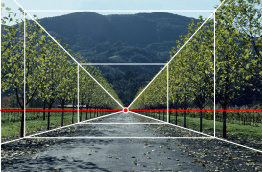Section 2
1. Section 2
1.6. Explore
Section 2: Perspective and Scale
Explore
In Discover you learned that moving the vanishing point in a one-point perspective drawing changes what side of the object you view. Artists use this type of perspective drawing to show the front of the object face on.
In a one-point perspective drawing, the lines drawn are vertical, horizontal, or diagonal. The diagonal lines are called orthogonal lines. All the orthogonal lines meet on the horizon at a single point called the vanishing point. Lines in a One-Point Perspective reviews all of the different lines in a one-point perspective drawing.
Practise this new terminology in the following Self-Check.
Self-Check 1

Brand X/Thinkstock
- The horizontal red line in the photograph is at the observer's eye level. What is the line called? Answer
- The road converges to the dot (point) located on the red line. What is that point called? Answer
- Assuming the trees are all approximately the same height, why do some trees appear to be so much smaller than others? Answer
- The sides of the road are perpendicular to the horizontal and vertical lines in the photograph. What are these lines called, including the lines along the tops of trees? Answer
- Through what point do all lines described in question 4 pass? Answer
- This photograph is an example of one-point perspective. Define one-point perspective. Answer

iStockphoto /Thinkstock
Example: Drawing a Bedroom in One-Point Perspective
You now have the terminology needed to sketch a one-point perspective drawing. The following Drawing a Bedroom in One-Point Perspective example describes the steps required to create a drawing in one-point perspective. You may find it beneficial to draw each step on your own sheet of paper—pause the animation when necessary.

